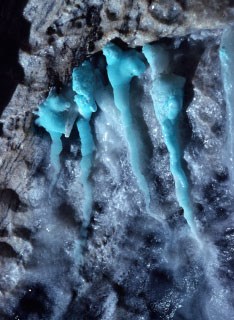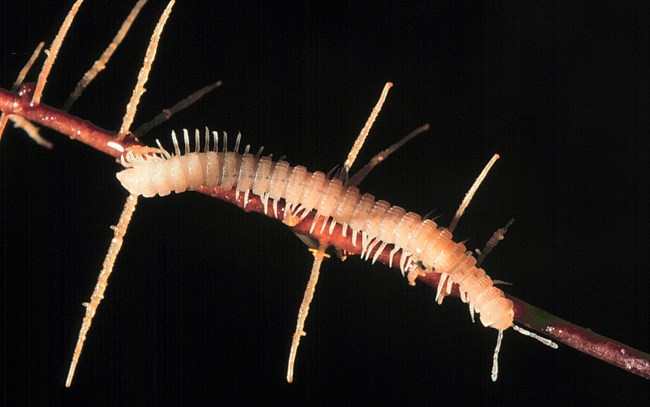
Photo courtesy of Dave Bunnell By some accounts Sequoia and Kings Canyon National Parks could have been set aside solely to protect the amazing caves found in this area of the Southern Sierra Nevada. The two parks protect half of the caves more than a mile long in California, the longest cave in the state, numerous karst streams, and some of the best alpine karst topography in the United States. The caves contain Pleistocene era fossils, rare minerals, and unique animals. They are the sites of numerous scientific research projects and provide recreational opportunities to thousands of park visitors each year. 
Photo courtesy of Bill Frantz Cave FeaturesCave formations (called “speleothems”) include long curtains, tall stalagmites, deep rimstone pools, masses of angular or curving growth forms called “helictites”, and 10-foot diameter shields. Park caves also display a diverse assemblage of colorful minerals. They form blue, green, yellow, black, white, orange, and red deposits and formations along walls, ceilings, and floors of caves. The parks’ caves include rooms 100 feet in diameter and tiny passages barely big enough for a small person to squeeze through. Some caves have active stream systems, while others are dry and abandoned remnants of ancient water-flow patterns. 
NPS Photo - Joel Despain Cave LifePark caves host a diversity of animals. Scientists have discovered at least 40 new invertebrate species since 1965. Cave invertebrates are remarkable in that many are endemic only to the parks. In some cases, they may occur only in one watershed, or even in an individual cave. In Clough Cave, three endemic invertebrates occur, and a total of 58 different species of animals are documented. These include spiders, a harvestman, scorpions, pseudoscorpions, centipedes, beetles, millipedes, flies, a mite, and many more types of invertebrates. Many of the invertebrates found in park caves are not only newly documented for the parks, but also new to science. Vertebrates also use park caves for roosting, shelter, and occasionally food sources; in Clough Cave, four bat species, a raccoon, a rodent, and a snake were documented. ThreatsPark cave formations can be damaged by human use of caves. See the Managing Caves page to learn more about how these parks manage caves to protect their fragile features and unique animals and restore caves that have been damaged. Animals that live in park caves can be affected by stressors that affect other park animals: climate change, air pollution, altered fire regimes, and land-use change. Some bat species in the eastern United States are in decline from a disease called White-nose Syndrome. Visit the National Park Service White-nose Syndrome page to learn more about this disease, and see the Crystal Cave page for information on reducing risk of this disease spreading to local caves, especially if you plan on taking a tour of this cave. |
Last updated: October 4, 2023
